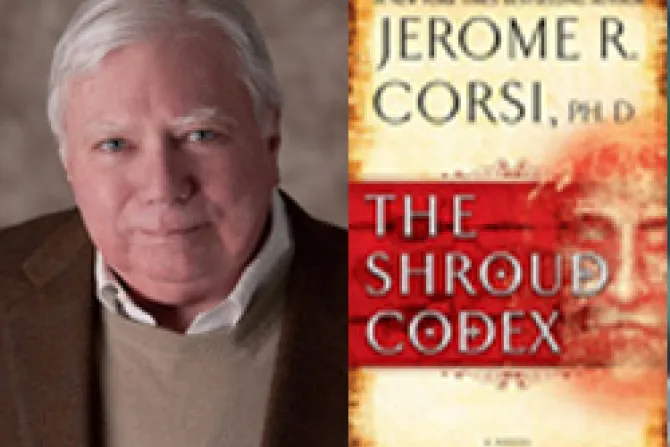Apr 18, 2010 / 16:50 pm
Author Jerome Corsi released his newest book Tuesday to what he hopes will be an audience of believers and unbelievers alike. His book, “The Shroud Codex” combines religion and science in a very realistic novel surrounding the mysterious Shroud of Turin.
“I have been fascinated with the Shroud since I first learned about it,” Corsi told CNA. “The Shroud has always made a profound impact on me and over the past few decades, I have collected books and read many scientific papers on the Shroud. I have always been impressed with how anatomically accurate the wounds of the crucified man in the Shroud are — even by today’s most advanced medical analyses. Also, the wounds are very faithful to the New Testament descriptions of Christ’s passion and death.”
“What made writing 'The Shroud Codex' fascinating for me was the opportunity to explore these issues of science and faith,” Corsi added. “I wanted both to entertain and to invite people to think. The Shroud is one of the enduring mysteries of faith,” he explained. Noting that most people simply accept the media emphasis that radiocarbon dating proving the Shroud to be a medieval forgery, Corsi’s book attempts to move beyond that, looking at both the science and the faith involved in the mysterious shroud.
Corsi also said that he was influenced by Dan Brown, author of “The DaVinci Code.” However, he was clear that he did not agree with Brown’s perspective. Brown proved that the religious mystery was something that the public was interested in, which paved the way for books such as “The Shroud Codex.” However, Brown’s position that the Catholic Church is opposed to science is not the case, Corsi argues. “Without the Catholic Church, the Dark Ages would have destroyed all prior science. If the Church were opposed to science, the 1978 Shroud of Turin Research Project would never have been organized.”
Another inspiration for Corsi was Michael Crichton, the prolific science fiction author. Crichton’s books, Corsi said, “proved you could engage a non-scientific public in questions of science, provided you told an entertaining enough story.” That is Corsi’s precise aim in his newest book, which mixes religious mystery, scientific fact, and a fictional storyline.
“The Shroud Codex” itself offers clear, layman-like explanations of scientific principles, from the radiocarbon dating used on the shroud to string theory and the possibility of alternate universes. Though Corsi says he believes the Shroud to be the actual burial cloth of Jesus, there are no easy answers or simple endings. One of the central characters is an avowed atheist, and the book ends with his continued doubts. Ultimately, the book, while not so much an adventure in literature as in faith, poses a question about humanity’s innate tendency towards religion, Catholic or not.
“I want the reader to explore the idea the Shroud itself is a “codex” in that the way the image was created is like a book we need modern science — and faith — to read the hidden message,” Corsi said. “The hidden message is about life — that our everyday dimension of experience is not all there is — and about the after-life — that everything does not end with death, much as atheists seem to believe.”
A review of the book can be found here: http://www.catholicnewsagency.com/column.php?n=1200


